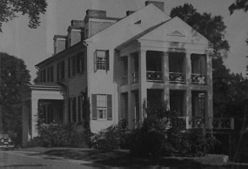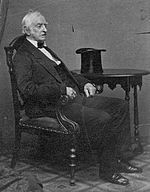- Dodon
-
Dodon 
Plantation house at Dodon, built c1800 to replace the original house which was destroyed by fire. This house in turn burned down c1953.[1]Alternative names Doden General information Type Mansion Architectural style Georgian, Victorian. Location Anne Arundel County Town or city Maryland Country USA Construction started Late 17th century Destroyed destroyed by fire c.1790s, again c.1953 Technical details Structural system Timber frame, brick. Dodon, (aka "Doden") is a 550-acre (2.2 km2) farm and former tobacco plantation in Maryland, located near the South River about 10 miles (16 km) south west of Annapolis. Purchased in around 1744 by the planter and politician Dr George H. Steuart, it remains the home of Steuart's descendants to this day. Steuart grew wealthy during the colonial era thanks to proprietorial patronage, but his family's prosperity and status would be much reduced by the American Revolution and later by the American Civil War.
Contents
History
One source suggests that Dodon was originally patented to one James Stewart in 1669, a Scottish immigrant from Perth.[2] Another suggests that it was owned by a Dr Francis Stockett, who "held 'Dodon', 664 acres", in 1668.[3] Whatever its early origins, the property was thereafter owned by the Carroll family and, in 1725, William Nicholas Carroll sold it Dr George H. Steuart (1700–1784) of Argaty, Perthshire, Scotland.[4][5] At Dodon, Steuart farmed the profitable cash crop of tobacco, bred thoroughbreds and held match races. His most famous horse was Dungannon, which he imported from England to compete against the stable of his rival Charles Carroll. The Annapolis Subscription Plate, the first recorded formal horse race in Maryland, was held in May 1743, and was won by Dungannon.[6] The silver cup - actually more of a bowl than a plate - is now displayed in the Baltimore Museum of Art. It is the oldest surviving silver object made in Maryland and the second oldest horse racing trophy in America.
Steuart held a number of colonial offices including Mayor of Annapolis from 1759-63. He was also Commissioner of the Land Office, served at the Court of Admiralty, and was appointed Lieutenant-Colonel of The Horse Militia in 1753 by Governor Horatio Sharpe.
Dodon formed a small part of the overall plantion economy of the Southern States, exporting tobacco to England, primarily using slave labor. Maryland planters also made extensive use of indentured servants and penal labor. An extensive system of rivers facilitated the movement of produce from inland plantations to the Atlantic coast for export. Baltimore was the second-most important port in the eighteenth-century South, after Charleston, South Carolina.
Revolutionary War
Steuart also inherited land in Perthshire, Scotland, which caused him considerable political difficulties during the Revolutionary War. Loyalty to the Revolution would have caused him to forfeit his Scottish estates, and, at the outbreak of hostilities, Steuart left America for Scotland. He thereafter divided his estates, giving Dodon to his wife Ann (née Digges), with instructions on which of his children, loyal to the new American nation, would inherit. Steuart himself would never return to Maryland or see his family again. Ann remained at Dodon until her death in 1811. According to letters of her Grandson Richard Sprigg Steuart (1797–1876), she lived "comfortably, but she kept at home because her good husband was called by the mob a Tory."[7]
Civil War
 Richard Sprigg Steuart, who inherited Dodon in 1834. Steuart was sympathetic to the Confederacy and smuggled horses and quinine south to Confederate forces.
Richard Sprigg Steuart, who inherited Dodon in 1834. Steuart was sympathetic to the Confederacy and smuggled horses and quinine south to Confederate forces.
In 1834 Dodon was inherited by the Maryland physician Richard Sprigg Steuart.[8][9] At that time the estate comprised around 1,600 acres (6.5 km2) of land and about 150 slaves.[1] The outbreak of the American Civil War in 1861 found the Steuart family sympathetic to the Southern cause, though Maryland did not secede from the Union (pre-war loyalties in Maryland were divided between North and South, but the Northern cause prevailed). Horses were raised and trained at Dodon then smuggled south for Confederate forces, as well as medical supplies such as quinine. As a result, Dodon was often raided by Union troops, regularly forcing Steuart to flee into hiding. As one family member later recalled:
- "Dr Steuart was constantly away from home, avoiding the raiding parties from the Northern soldiers who sought to capture him, because of the help he gave the South by secretly sending supplies of quinine, and other necessities...to the Southern hospitals. Wakened...in the dead of night, [his wife Maria] dressed quietly and...admitted the Northern soldiers, and then stealing past the sentries, walked half a mile to the quarters, and sent a trusty messenger to warn his master not to return. Old William Hawkins, when a soldier put a pistol to his head saying 'tell us where your master is', replied 'I'd rather be dead than tell'."[1]
Steuart's nephew, Brigadier Gen. George H. Steuart (1828–1903) (Known as "Maryland Steuart" to distinguish him from his fellow General J.E.B. Stuart) fought at a number of major battles including Spotsylvania, Gettysburg, Cross Keys and Winchester, before surrendering with General Lee at Appomattox court house.
Post War Period
The estate did not prosper after the war's end, in part due to the losses caused by the freeing of the slaves.[1] In 1890 Isabel and Emily Steuart, daughters of Richard Sprigg Steuart, donated the estate to the Roman Catholic Congregation of Marist Fathers, a French order founded in Lyon in 1826, to be used as a seminary and mission.[10][11] However, it was eventually repurchased by a member of the Steuart family, Annette Steuart Wise, in 1929.[12]
Legacy
Stone obelisk marking Dodon burial ground, erected by Richard Sprigg Steuart.[13]
Dodon is still home to the eighth generation of Steuarts today, who continue to farm, and to breed and race horses. The Annapolis Subscription Plate has also been revived in recent years. Parts of the original house still remain, though most was destroyed in a fire c1950.[14]
Dodon is not far from the expanding suburbs of Annapolis, and the remaining land has now been put into preservation through the Maryland Agricultural Land Preservation Foundation, in order to prevent future development.
A family graveyard, marked by a small obelisk listing the names of Steuart kin resting there, sits in a grove of trees on one of the high spots of the property.
The name Dodon is said to come from the French, "Dieu Donne" meaning "Gift of God."[11] It may also be a derivative of the Greek, Dodona - a prehistoric oracle in Greece dedicated to Zeus and the "mother goddess," Dione.[14]
See also
References
- Carey, John L., p.2, Slavery in Maryland briefly Considered (1845) Retrieved February 25, 2010
- Nelker, Gladys P., The Clan Steuart, Genealogical Publishing, 1970.
- Richardson, Hester Dorsey, Side-Lights on Maryland History, Tidewater Publishers, Cambridge, Maryland, 1967.
- Steuart, Richard Sprigg, "Letter to John L. Carey on the Subject of Slavery", Published by J Murphy, 1845. ASIN: B00089CM7M
- Tyson, Philip T., p.20, First Report to the House of Delegates of Maryland. (1860) Retrieved February 25, 2010
- Warfield, J. D., p.93, The Founders of Anne Arundel and Howard Counties, Maryland Retrieved February 25, 2010
External links
- Official Dodon website and history of the estate Retrieved February 22, 2010
Notes
- ^ a b c d Nelker p.150
- ^ Nelker, 132
- ^ Warfield, J. D., p.93, The Founders of Anne Arundel and Howard Counties, Maryland Retrieved February 25, 2010
- ^ Nelker, 118,132
- ^ Harrison, Bruce, p.559, The Family Forest Descendants of Lady Joan Beaufort Retrieved October 2010
- ^ Nelker, 118
- ^ Nelker, 128
- ^ Carey, John L., p.2, Slavery in Maryland briefly Considered (1845) Retrieved February 25, 2010
- ^ Tyson, Philip T., p.20, First Report to the House of Delegates of Maryland. (1860) Retrieved February 25, 2010
- ^ Richardson, p.226
- ^ a b Nelker, p.151
- ^ Nelker, p.152
- ^ Nelker, 131
- ^ a b History of Dodon Farm Retrieved February 25, 2010
Coordinates: 38°53′35″N 76°37′32″W / 38.89306°N 76.62556°W
Categories:- Houses in Maryland
- Plantations in Maryland
- Steuart family
Wikimedia Foundation. 2010.

